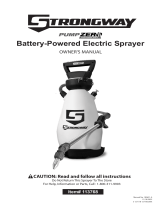
2E
WARNING: For safe operation, read this manual before using the charger.
The battery pack is not fully charged out of the carton. Before using the battery pack and
charger, read the safety instructions below. Then follow charging procedures outlined.
READ ALL INSTRUCTIONS
IMPORTANT SAFETY INSTRUCTION FOR BATTERY PACKS
• Donotincineratethebatterypackevenifitisseverelydamagedoriscompletelyworn
out. The battery pack can explode in a fire. Toxic fumes and materials are created when battery packs
are burned.
• DoNotchargeorusebatteryinexplosiveatmospheres,suchasinthepresenceof
ammableliquids,gasesordust. Inserting or removing the battery from the charger may ignite the
dust or fumes.
• Ifbatterycontentscomeintocontactwiththeskin,immediatelywashareawithmild
soapandwater. If battery liquid gets into the eye, rinse water over the open eye for 15 minutes or
until irritation ceases. If medical attention is needed, the battery electrolyte for Lithium-Ion batteries is
composed of a mixture of liquid organic carbonates and lithium salts.
• Contentsofopenedbatterycellsmaycauserespiratoryirritation. Provide fresh air. If
symptoms persist, seek medical attention.
WARNING: Burn hazard. Battery liquid may be flammable if exposed to spark or flame.
• Charge the battery packs only in Black&Decker chargers.
•DONOTsplashorimmerseinwaterorotherliquids. This may cause premature cell failure.
•Donotstoreorusethetoolandbatterypackinlocationswherethetemperaturemay
reachorexceed105ºF(40ºC)(suchasoutsideshedsormetalbuildingsinsummer).
WARNING: Never attempt to open the battery pack for any reason. If battery pack case is cracked or
damaged, do not insert into charger. Do not crush, drop or damage battery pack. Do not use a battery
pack or charger that has received a sharp blow, been dropped, run over or damaged in any way (i.e.,
pierced with a nail, hit with a hammer, stepped on). Damaged battery packs should be returned to
service center for recycling.
WARNING:Firehazard.Donotstoreorcarrybatterysothatmetalobjectscancontact
exposedbatteryterminals. For example, do not place battery in aprons, pockets, tool boxes, product
kit boxes, drawers, etc., with loose nails, screws, keys, etc.
Transportingbatteriescanpossiblycauseresifthebatteryterminalsinadvertentlycome
incontactwithconductivematerialssuchaskeys,coins,handtoolsandthelike.The US
Department of transportation Hazardous Material Regulations (HMR) actually prohibit transporting
batteries in commerce or on airplanes (i.e., packed in suitcases and carry-on luggage) UNLESS they
are properly protected from short circuits. So when transporting individual batteries, make sure that the
battery terminals are protected and well insulated from materials that could contact them and cause a
short circuit. NOTE:Lithium-Ionbatteriesshouldnotbeputincheckedbaggage.
STORAGERECOMMENDATIONS
1. The best storage place is one that is cool and dry away from direct sunlight and excess heat or cold.
2. Long storage will not harm the battery pack or charger.
CHARGINGPROCEDURE
Black&Deckerchargers are designed to charge
Black&Deckerbattery packs in 3.5-4 hours depending
on the pack being charged.
1. Plug the charger into an appropriate outlet before inserting the
battery pack.
2. Insert the battery pack into the charger as shown in gureA.
3. The green LED will flash indicating that the battery is being charged.
4. The completion of charge is indicated by the green LED remaining on continuously. The pack is fully
charged and may be used at this time or left on the charger.
A














